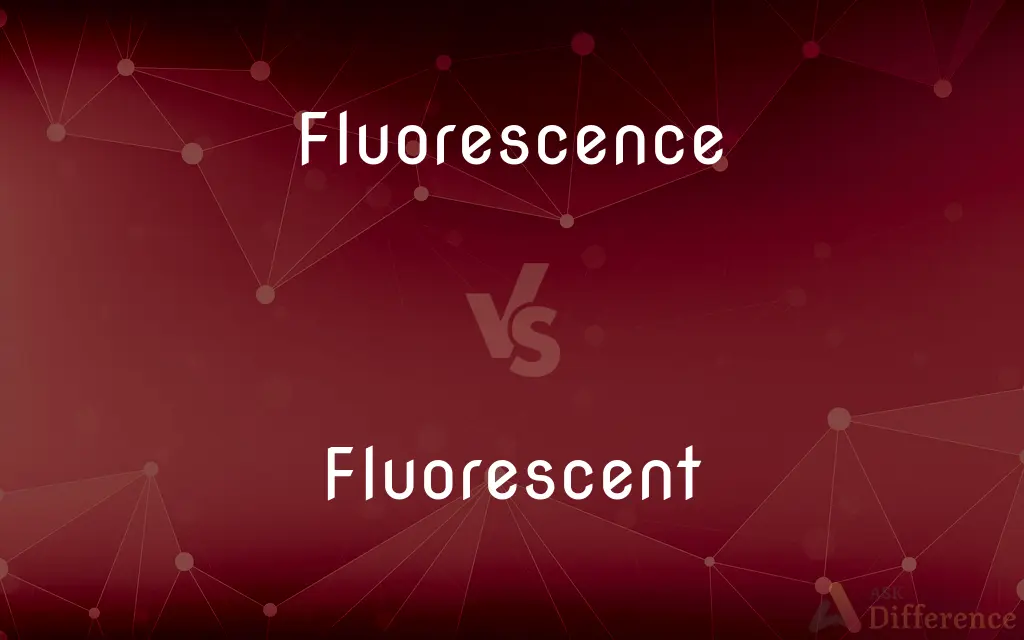Fluorescence vs. Fluorescent — What's the Difference?
By Urooj Arif & Fiza Rafique — Updated on April 3, 2024
Fluorescence is a physical phenomenon where light is emitted by a substance, whereas fluorescent refers to materials or objects that exhibit fluorescence.

Difference Between Fluorescence and Fluorescent
Table of Contents
ADVERTISEMENT
Key Differences
Fluorescence is the emission of light by a substance that has absorbed light or electromagnetic radiation. It is a form of luminescence. In most cases, the emitted light has a longer wavelength, and therefore lower energy, than the absorbed radiation. On the other hand, fluorescent describes the property of a material or an object that can emit light through fluorescence. This characteristic is key in various applications, including lighting, bioimaging, and material science.
The process of fluorescence occurs when an atom or molecule absorbs photons, exciting electrons to a higher energy level. Once excited, these electrons return to their ground state, releasing energy in the form of light. Whereas, materials that are described as fluorescent contain substances (fluorophores) that can undergo this process, making them useful in creating visible or ultraviolet light from light of a different wavelength.
Fluorescence typically stops almost immediately when the exciting source is removed, distinguishing it from phosphorescence, where the emitted light can continue for some time. Fluorescent materials, therefore, require a constant source of exciting light to maintain their glow, making them ideal for applications where instant on/off lighting effects are desirable.
In practical applications, fluorescence is harnessed in fluorescent lamps, where electric current excites mercury vapor, producing short-wave ultraviolet light that then causes the fluorescent coating inside the lamp to emit visible light. Fluorescent materials are also widely used in biological and chemical research, where they can be attached to molecules of interest to visualize processes under a microscope.
While fluorescence is a broad term encompassing the phenomenon in various contexts, fluorescent specifically refers to the capability or characteristic of a material or object. This distinction is important in scientific, industrial, and commercial contexts, where the precise understanding and application of these terms can lead to innovations in technology and new research methodologies.
ADVERTISEMENT
Comparison Chart
Definition
Emission of light by a substance after absorbing electromagnetic radiation
Describes materials or objects that can emit light through fluorescence
Nature
Phenomenon
Descriptor/Property
Dependency on Light Source
Emission stops when the source is removed
Requires constant exciting light for emission
Applications
Scientific research, lighting, bioimaging
Producing visible light in lamps, markers, and signs
Example of Use
Fluorescence microscopy to observe biological samples
Fluorescent lamps used for efficient lighting
Compare with Definitions
Fluorescence
Observable under ultraviolet light as a visible glow.
The room’s fluorescence was evident when the black light was turned on.
Fluorescent
Describes materials that emit light via fluorescence.
Fluorescent paints glow under black light.
Fluorescence
Utilized in various scientific and practical applications.
Fluorescence in gemstones can be observed under UV light.
Fluorescent
Often applied in bioimaging and analytical chemistry.
Fluorescent dyes help visualize cellular components under a microscope.
Fluorescence
Emission of light by a substance that has absorbed light.
Fluorescence microscopy allows for detailed imaging of cells.
Fluorescent
Used in lighting to produce bright, energy-efficient light.
Fluorescent bulbs are common in office settings.
Fluorescence
Can occur in a wide range of substances, including minerals, chemicals, and biological entities.
The fluorescence of chlorophyll is used to study plant health.
Fluorescent
Characteristic of substances used in various visibility-enhancing applications.
Fluorescent vests are worn for safety in low-light conditions.
Fluorescence
A form of luminescence distinguished by its rapid cessation when the exciting source is removed.
The fluorescence of the sample ceased immediately after turning off the UV light.
Fluorescent
Materials or objects capable of converting UV light to visible light.
Fluorescent markers are used for highlighting text.
Fluorescence
Fluorescence is the emission of light by a substance that has absorbed light or other electromagnetic radiation. It is a form of luminescence.
Fluorescent
Of or relating to fluorescence.
Fluorescence
The emission of electromagnetic radiation, especially of visible light, stimulated in a substance by the absorption of incident radiation and persisting only as long as the stimulating radiation is continued.
Fluorescent
Exhibiting or produced by fluorescence
Fluorescent corals.
Fluorescent light.
Fluorescence
The property of emitting such radiation.
Fluorescent
Glowing as if with fluorescence; vivid
Bright fluorescent colors.
Fluorescence
The radiation so emitted.
Fluorescent
Of or relating to a light bulb that produces visible light by fluorescence, especially a glass tube whose inner wall is coated with a material that fluoresces when an electrical current causes a vapor within the tube to discharge photons.
Fluorescence
(physics) The emission of light (or other electromagnetic radiation) by a material when stimulated by the absorption of radiation or of a subatomic particle.
Fluorescent
A fluorescent light bulb.
Fluorescence
The light so emitted.
Fluorescent
A lamp that is fitted with a fluorescent light bulb.
Fluorescence
A luminescence emitted by certain substances due to the absorption of radiation at one wavelength, and the almost instantaneous re-emission of radiation at another, usually longer wavelength. The re-radiation stops almost as soon as the incident radiation is halted, thus distinguishing this phenomenon from phosphorescence, in which re-radiation of light may continue for some time after the incident radiation is halted.
Fluorescent
Of or relating to fluorescence.
Fluorescence
Light emitted during absorption of radiation of some other (invisible) wavelength
Fluorescent
Exhibiting or produced by fluorescence.
The fluorescent plants shimmered in the darkness.
Fluorescent
Emitting visible light as a result of the excitation of phosphors by ultraviolet photons produced by the passage of an electrical current through an inert gas infused with mercury.
The quality of fluorescent lighting technology has improved dramatically in recent years.
Fluorescent
Glowing as if with fluorescence; vivid
Her shirt was fluorescent orange.
Fluorescent
A fluorescent light.
The fluorescents hummed day and night.
Fluorescent
Having the property of fluorescence.
Fluorescent
Emitting light during exposure to radiation from an external source
Fluorescent
Brilliantly colored and apparently giving off light;
Fluorescent colors
Common Curiosities
What are the applications of fluorescence?
Applications include scientific research, bioimaging, and efficient lighting solutions.
How do fluorescent materials work?
Fluorescent materials contain substances that absorb light at one wavelength and emit it at another, longer wavelength.
What is the difference between fluorescent and phosphorescent materials?
Fluorescent materials emit light almost immediately after absorbing light, whereas phosphorescent materials continue to glow even after the light source is removed.
What does fluorescent mean?
Fluorescent refers to materials or objects capable of emitting light through the process of fluorescence.
What makes a material fluorescent?
A material is made fluorescent by the inclusion of fluorophores, which are capable of the fluorescence process.
Are all fluorescent lights energy-efficient?
Yes, fluorescent lights are generally more energy-efficient than traditional incandescent bulbs.
Can fluorescence be used for security purposes?
Yes, fluorescent materials are used in security tags and high-visibility clothing for safety and identification.
What is the role of fluorescence in nature?
In nature, fluorescence can serve various purposes, including protection, attraction, and camouflage for different organisms.
Why are fluorescent dyes important in microscopy?
They allow scientists to specifically highlight certain components of complex biological structures for detailed study.
What is fluorescence?
Fluorescence is the emission of light by a substance that has absorbed light or other electromagnetic radiation.
Can fluorescence occur in any color?
Yes, fluorescence can occur in a wide range of colors, depending on the material and the wavelength of absorbed light.
Is fluorescence a chemical or physical process?
Fluorescence is a physical process related to the behavior of electrons within atoms or molecules.
Can fluorescence be harmful?
Fluorescence itself is not harmful, but prolonged exposure to the intense light sources used to excite fluorescence can be harmful to the eyes or skin.
What is a common use of fluorescent materials?
A common use is in fluorescent lamps, where they convert UV light into visible light.
How is fluorescence detected?
It is usually detected with the help of a fluorescence microscope or UV light sources.
Share Your Discovery

Previous Comparison
Drag vs. Pull
Next Comparison
Venue vs. AddressAuthor Spotlight
Written by
Urooj ArifUrooj is a skilled content writer at Ask Difference, known for her exceptional ability to simplify complex topics into engaging and informative content. With a passion for research and a flair for clear, concise writing, she consistently delivers articles that resonate with our diverse audience.
Co-written by
Fiza RafiqueFiza Rafique is a skilled content writer at AskDifference.com, where she meticulously refines and enhances written pieces. Drawing from her vast editorial expertise, Fiza ensures clarity, accuracy, and precision in every article. Passionate about language, she continually seeks to elevate the quality of content for readers worldwide.














































